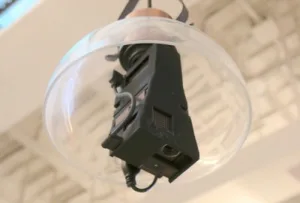The MIT Technology Review reports on “Augmented Reality on Your Desk—All You Need Is a Lightbulb Socket” as a new way to interact with your electronic devices. This device prototype is based on the work of the Future Interfaces Group at Carnegie Mellon University, Pittsburgh, PA. They call this approach Desktopography as it allows the user to project various content onto real life surfaces. In addition the developers added a multitouch ability based on an included camera system. The whole system can be screwed into a light fixture overhead and can project various objects like calculators and maps on the surface. The objects can be resized and moved through multitouch based input.
 Carnegie Mellon projection prototype for Desktopography
Carnegie Mellon projection prototype for Desktopography
While this approach is not entirely new (touch enabled projected keyboards are around for quite some time without ever capturing any substantial market share), this implementation is a fixed installation that promises to provide a more flexible user interface to the user while easily adopting to ever changing desk configurations. The research group acknowledges that it will take some time before this technology can be commercialized. The topic was also presented at EICS 2017 under the title “Supporting Responsive Cohabitation Between Virtual Interfaces and Physical Objects on Everyday Surfaces“. This paper gives a more in depth look at the target of the research. In addition you see the device at work in this video.
Analyst Comment
As a new form of human machine interface this work has been going on for quite some time. With the event of the augmented reality craze the researchers have seen a chance to get a little more recognition in the international press by using the word augmented reality with the device. In a certain way, this system actually adds some information to the real world, but so does every projected content or flat screen monitor for that matter. This leaves the question of whether this is actually considered ‘augmented reality’ or not. Even basic research needs some good marketing once in a while. (NH)

